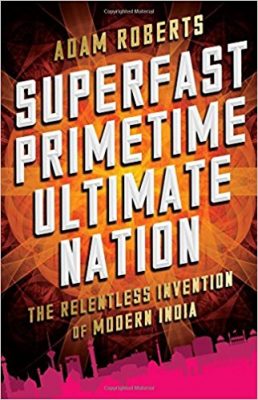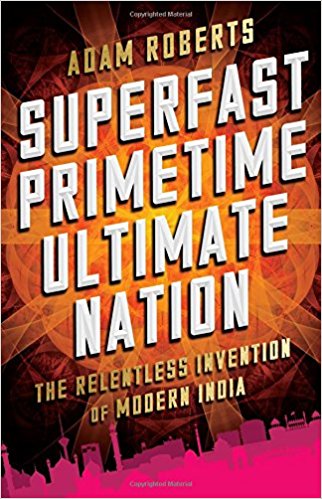 Author: Adam Roberts
Author: Adam Roberts
Publisher: Public Affairs, an imprint of Perseus Books – 312 pages
Book Review by: Sonu Chandiram
If you are wondering why such a boastful title was conceived of, for this book, it is because these days, almost every business in India’s economy, politics, sports, or whatever, is making exaggerated claims about the product, person, place, or service it is promoting, the author Adam Roberts points out, both in his Preface and his Introduction.
Marketing hype has now become the norm in India and it is working very well with a mostly-gullible, but hopeful public.
“Understatement gets you nowhere in crowded, noisy, easily distracted. India. Even overstatement often falls short. In India, a land of bombastic claims, you must be bold. It is not enough, for example, to build a shiny new electricity plant. Instead you should brag about your forthcoming ‘Ultra Mega Power Project.’ Want to describe a hospital? Then call it a ‘Max Clinic’ or ‘Max Super Specialty’ and slap up the name in neon lights,” Roberts writes.
You may be smiling or even laughing out loud at such braggadocio, but it works. Optimism is pervasive in a country that is projected by the United Nations to become the world’s most populous by 2030, with over 1.527 billion people, outstripping China which currently has the most people. More mouths to feed? Let’s look at it positively: India, like China, enjoys a huge demographic dividend, with a larger and much younger labor force than countries in the West!
And in a country where astrologers are often consulted and their predictions taken seriously, outrageous forecasts are taken at face value. The author mentions an encounter he had with one such 45-year-old prognosticator named Bhim Joshi, whom he met in south Delhi.
Joshi, living in a in a single-room home with one bed, one chair, and one light bulb dangling from a cord, answered a question the author posed to him through a translator – “What does he say about India’s future?” He replied: “a little trouble, but India will get support. The economy is in trouble, but will revive…then India’s place in the world will be number one.” He repeats, with a smile” “Number One!”
“Number One” will probably never happen, and if it does, it will be a very, very long time in coming. India currently ranks No.6 in the world, with about $2.454 trillion in nominal Gross Domestic Product, just about an eighth in size of the United States $19.417 trillion GDP, according to the International Monetary Fund. More striking in contrast are the average annual earnings of its people. The average Indian earns $1,723 a year, less than three percent of the average American making $57,436.
Huge hopes and expanding expectations took root when Narendra Modi became the 14th Prime Minister in May 2014. Much has been accomplished for the country by Modi, the highly successful former Chief Minister of the state of Gujarat, but the road ahead to well-being for the 1.34 billion people in India is a long and difficult one.
Poverty, lack of sanitation, government corruption, debt bondage among farmers and laborers, poor educational opportunities, and a low literacy rate, are among the major problems facing people in India. And there are numerous interrelated minor problems, too numerous to mention here. All of these issues are causes of why 24 percent of Indians live on less than $1.25 a day, according to the World Bank.
But Roberts takes a hopeful approach and cheerful tone through the course of his book. It consists of 17 chapters organized around four Parts. Here below is an overview of its contents:
Introduction: Superfast Primetime Ultimate Nation
- Part I. Superfast – Economy
- View from a Stopping Train
- Argumentative Indians
- After the Sonia-and-Singh Show
- Bring Back the Golden Bird
- Tech Dreams and Silver Bullets
- Part II. Primetime – Politics
- Weaker Families, Stronger Democracy
- Seasons of Scams
- Elections Never End, But They Improve
- India’s Women, India’s Men
- Tackling the Tragedy of the Commons
- Part III. Ultimate – Abroad
- Lifting an Old Curse from Pakistan
- A Shadow Cast from the East
- America Calls
- Part IV. Nation – Home
- Hindutva Nation?
- Why Gujarat, 2002, Still Matters
- The Power of Mingling
- Liberals Under Pressure
Conclusion: Party Like it’s 2047
Roberts continues with his optimistic outlook and even concludes “in various ways, predictions of ‘Number One’ will have come true” He observes that as Narendra Modi became Prime Minister in 2014 with a large mandate, voters had become increasingly worried about their financial situations.
At that point, “they were ready to reward – or punish – politicians according to their ability to deliver jobs, rising incomes, and a more stable country. The rise of Modi however, also marked a growing sense of nationalism among voters and more self-confidence among the Hindu right.”
Adam Roberts points out in his Conclusion:
“More investment in infrastructure such as better train lines, power lines, and Internet connections, plus tarred roads and new airports, would deliver concrete gains that people could appreciate directly.”
The onset of new technology and its rapid development enabled India’s economy to grow and help raise the people’s incomes grew, especially after its tech firms began supplying services to companies in Europe and the United. In recent years, larger Indian tech firms have gone further and outright purchased in whole or parts of, firms located in these and other parts of the world.
This will further expand the country’s GDP. In short, the prospects for India are bright, but it is too early to predict the size of its economy 10 or 20 years from now, and very importantly, the much-needed widespread rising incomes for the country’s broad masses.
Author:
Adam Roberts spent five years in India as the Economist’s South Asia correspondent. Previously the Southern Africa correspondent in Johannesburg and the news editor of Economist.com, he is now the European business and financial correspondent in Paris. He is the author of the Economist’s 2015 special report on India and the Wonga Coup.







